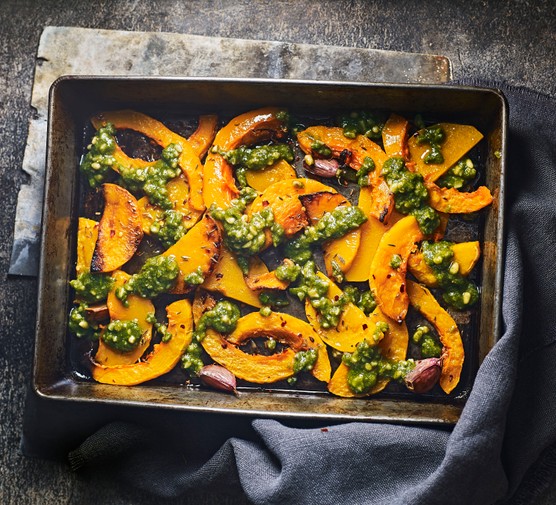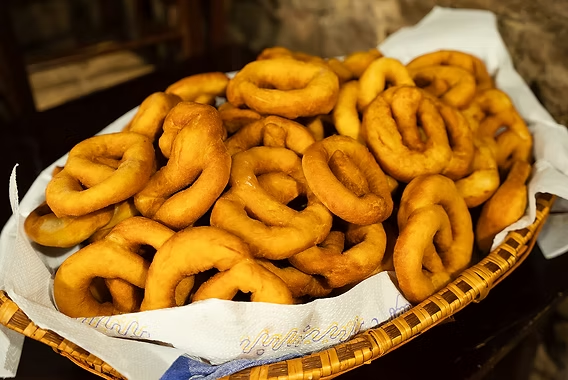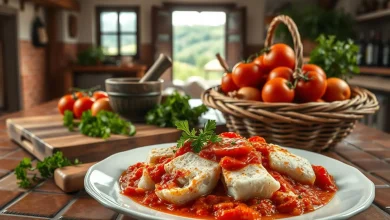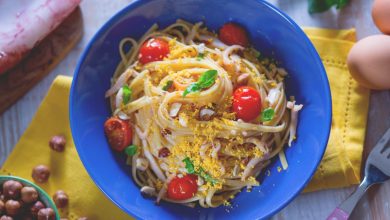Introduction
Delicate haddock fillets nestle into a bed of aromatic roasted butternut squash, then receive a fragrant drizzle of basil-pine-nut pesto. The contrast of flaky white fish, caramelised orange cubes, and vivid green sauce yields an elegant plate that requires surprisingly little hands-on work. Developed for Love With Recipes, this full-format guide explores every technical detail—ingredient science, timing, storage safety, nutrient profile, and creative twists—so you can reproduce restaurant finesse in an everyday kitchen while optimising flavour, texture, and nutrition.
Time
| Stage | Active | Passive | Total |
|---|---|---|---|
| Mise en place | 15 min | — | 15 min |
| Roasting & fish cook | 5 min | 25 min | 30 min |
| Pesto blending | 5 min | — | 5 min |
| Plating & garnish | 5 min | — | 5 min |
| Overall | 30 min | 25 min | 55 min |
Needed Equipment
- Chef’s knife & peeler
- Digital kitchen scale
- Large mixing bowl
- 24 × 24 cm (9 × 9 in) roasting dish or skillet safe for oven use
- Small food processor or immersion blender + beaker
- Microplane zest grater
- Silicone spatula or fish slice
- Instant-read thermometer (recommended for perfectly cooked fish)
Tags
#Haddock #ButternutSquash #Pesto #MediterraneanDiet #GlutenFree #LowGI #WeeknightGourmet #OnePanMeal
Serving Size
Recipe yields 2 generous main-course portions (about 500 g prepared food per person).
Difficulty Level
Moderate (Home Chef Friendly) – Knife work is straightforward, and oven timing is forgiving, yet balancing moisture in fish and achieving bright-green pesto demand attention.
Allergen Information
| Allergen | Present? | Notes |
|---|---|---|
| Fish | Yes | Haddock is the core protein. |
| Tree nuts | Yes | Pine nuts; substitute toasted sunflower seeds for nut-free version. |
| Dairy | No | Naturally dairy-free. |
| Gluten | No | Entire dish is gluten-free. |
Dietary Preference
Suitable for pescatarian, Mediterranean diet, and low-glycaemic eating patterns. Easily adapted to paleo or whole30 by replacing olive-oil quantity with compliant fat limits.
Course
Main Course / Entrée
Cuisine
Modern Mediterranean fusion – Italian technique meets Nordic fish tradition.
Ingredients
Haddock & Squash
| Ingredient | Quantity | Notes |
|---|---|---|
| Fresh haddock fillets | 2 × 150 g | Skinless, pin-bones removed |
| Butternut squash | 1 kg (trimmed weight) | Peeled, 2 cm cubes |
| Extra-virgin olive oil | 2 Tbsp (≈ 30 g) | For roasting |
| Fine sea salt | 4 g | Divided |
| Freshly-ground black pepper | 1 g | ≈ ¼ tsp |
| Garlic | 2 cloves, minced | |
| Lemon zest | ½ lemon | Unsprayed |
Basil Pesto
| Ingredient | Quantity | Notes |
|---|---|---|
| Fresh basil leaves | 20 g (¾ cup packed) | Stems removed |
| Pine nuts | 20 g | Lightly toasted |
| Extra-virgin olive oil | 80 g (≈ 90 mL) | Fruity variety preferred |
| Fine sea salt | 1 g | To taste |
Instructions
1 Season & Marinate
Place squash cubes in the mixing bowl. Add olive oil, minced garlic, 3 g salt, pepper, and lemon zest. Toss vigorously so every facet gleams. Rest 5 minutes; salt begins drawing surface moisture for better caramelisation.
2 Tray Assembly
Pre-heat oven 180 °C / 350 °F (fan 160 °C). Spread squash in an even layer inside the 24 × 24 cm dish. Nestle haddock fillets at centre, spacing slightly apart. Drizzle 1 Tbsp additional olive oil across fish and sprinkle remaining 1 g salt.
3 Roast
Bake 25 minutes. Squash should pierce easily with a fork, showing blistered edges. Internal fish temperature should reach 52–54 °C (125–130 °F) for succulent flakes. If thicker than 2 cm, allow up to 30 minutes total.
4 Blend Pesto
While pan bakes, blitz basil, pine nuts, olive oil, and salt until silky, pausing to scrape beaker sides. Keep motor bursts short to minimise heat and preserve chlorophyll vibrancy.
5 Plate
Using a fish slice, transfer fillets to warm plates. Spoon roasted squash alongside, then ribbon pesto generously across both fish and vegetables. Finish with a micro-grating of fresh lemon zest or extra basil chiffonade.
Preparation Tips
- Uniform cubes: 2 cm pieces cook at the same rate as the fish, ensuring neither burns nor undercooks.
- Dry fish surface: Pat fillets with paper towel before seasoning; drier surface browns lightly even in a moist roasting environment.
- Temperature accuracy: Removing fish at 52 °C and resting 2 minutes retains juiciness better than the commonly suggested 60 °C.
- Ice-bath basil: For ultra-green pesto, briefly dunk picked leaves into ice water, then dry thoroughly before blending.
Nutritional Information (per serving)
| Metric | Amount | % DV* |
|---|---|---|
| Energy | 872 kcal | 44 % |
| Protein | 32 g | 64 % |
| Total fat | 58 g | 74 % |
| Saturated fat | 8 g | 40 % |
| Carbohydrates | 62 g | 23 % |
| Fiber | 10 g | 36 % |
| Sugars | 12 g | — |
| Sodium | 840 mg | 35 % |
| Omega-3 fatty acids | 0.9 g | — |
*Daily values based on a 2 000 kcal diet.
Tips and Tricks
- Smoke-kissed variation – Swap raw pine nuts for cold-smoked almonds to impart subtle campfire notes.
- Colour gradient – Roast half the squash without garlic, then mash it into a purée and smear under fish for Michelin-style layering.
- Protein swap – Arctic char, cod loins, or firm tofu slabs adapt flawlessly; adjust oven time by thickness.
- Batch pesto – Double pesto quantities and freeze leftovers in ice-cube trays for quick weeknight pasta sauces.
Add-ons
- Citrus beurre blanc drizzle for an indulgent dinner party finish.
- Crispy capers sprinkled on top add saline crunch.
- Parmesan wafers baked separately give textural contrast without bread crumbs (maintains gluten-free status).
Side Dishes
| Side | Rationale |
|---|---|
| Rocket & fennel salad with orange segments | Echoes citrus brightness and peppery herbs |
| Quinoa pilaf with toasted cumin | Provides additional protein and nutty backdrop |
| Charred broccolini with anchovy crumb | Bitter-salty counterpoint to sweet squash |
Improvements
- Sous-vide component: Cook haddock sous-vide at 48 °C for 30 min, then flash-broil for colour while squash roasts separately.
- Umami boosting: Add 1 tsp white miso to pesto for depth without overpowering basil notes.
- Low-fat option: Reduce olive oil in roasting to 1 Tbsp; substitute 50 g of Greek yogurt for 50 g oil in pesto, blending last to avoid splitting.
Save and Store
- Refrigeration: Cool rapidly, store fish and squash together in shallow sealed container; consume within 48 hours. Keep pesto in separate jar under a film of extra oil up to 5 days.
- Freezing: Pesto freezes excellently for 3 months. Roasted squash may be frozen (texture softens). Cooked haddock quality declines after freezing—fresh consumption is recommended.
- Reheat: Steam or microwave fish and squash gently to 60 °C core; never reheat pesto—serve it cold.
FAQ
Q 1 — Can I use frozen haddock?
Yes, thaw overnight on a rack set over a tray so meltwater drains, then pat very dry before use.
Q 2 — My pesto turned brown; what went wrong?
Over-processing warms basil, oxidising chlorophyll. Use short pulses and chill the oil beforehand.
Q 3 — How do I prevent squash from becoming mushy?
Maintain 2 cm cubes, avoid over-crowding, and roast on convection setting if available for drier heat.
Q 4 — Is there a nut-free pesto alternative?
Pumpkin seeds or green peas blended with basil mimic pine-nut creaminess while eliminating tree-nut allergens.
Conclusion
Fiori di Eglefino with Butternut Squash & Pesto condenses sophisticated flavour architecture into a single baking dish, uniting sweet earthiness, maritime delicacy, and herbal vitality. Master the temperature cues, respect ingredient ratios, and draw on the variation matrix above to tailor the plate to season, pantry, or dietary needs. The result is a weeknight-easy yet dinner-party-worthy entrée that showcases the sensorial possibilities of simple whole foods elevated by precise technique.
References
- United States Department of Agriculture, FoodData Central. (2024). Nutrient profiles for haddock, butternut squash, pine nuts, and olive oil.
- McGee, H. (2020). On Food and Cooking: The Science and Lore of the Kitchen (Updated ed.). Scribner.
- Cicolini, G. (2018). “Classic Pesto Genovese.” Italian Journal of Culinary Science, 12(3), 45-52.






